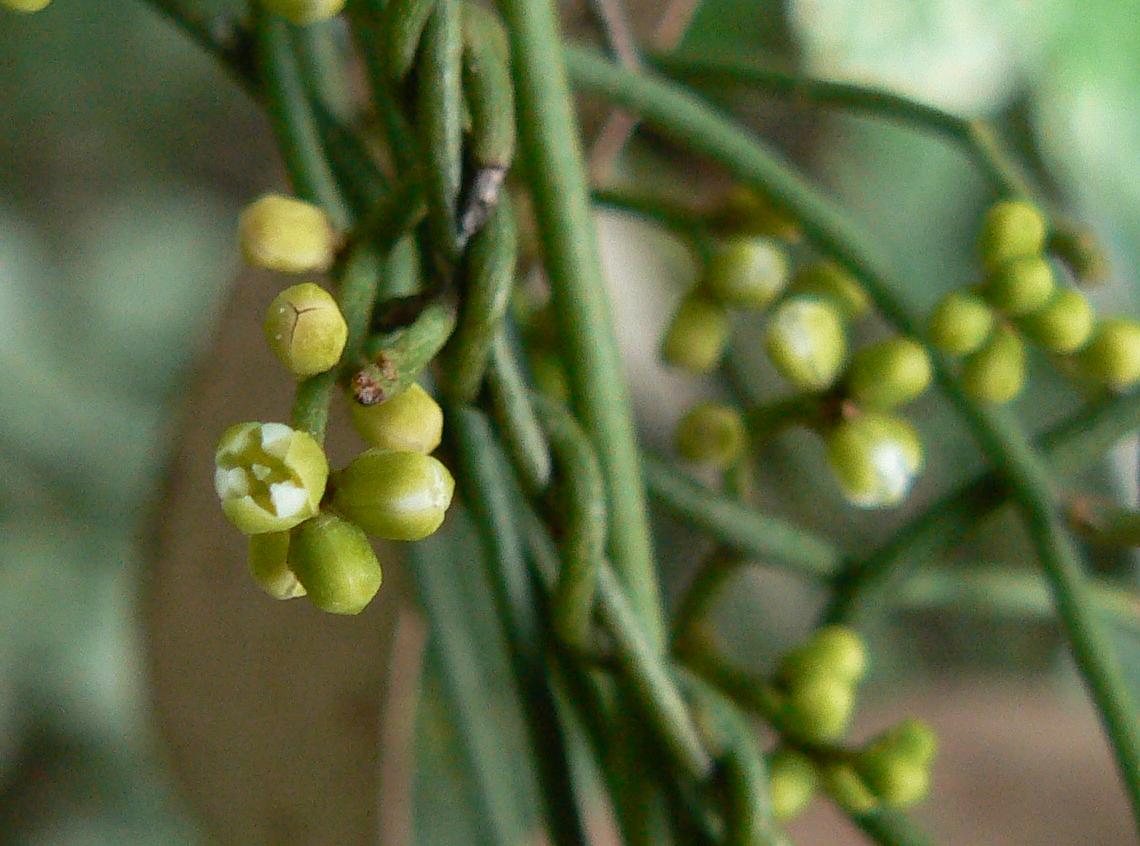Strangleweed
(Cassytha paniculata)

Description
Cassytha paniculata, commonly known as twining dodder vine or strangleweed, is a parasitic plant species belonging to the family Lauraceae. This unique and intriguing plant is found in various regions across the world, including Australia, Southeast Asia, and the Pacific Islands. Cassytha paniculata has attracted the attention of botanists and plant enthusiasts due to its fascinating adaptability and distinct parasitic nature. In this article, we will explore the characteristics, life cycle, ecological significance, and potential uses of Cassytha paniculata. Taxonomy and Nomenclature Cassytha paniculata falls under the plant kingdom (Plantae) and the angiosperm division (Magnoliophyta). It is a member of the order Laurales and the family Lauraceae, which includes other notable plants such as cinnamon and bay laurel. The genus name "Cassytha" is derived from the Greek word "kassythein," meaning "to bind tightly," alluding to the plant's twining habit. The species epithet "paniculata" refers to the arrangement of the plant's inflorescence in panicles. Physical Characteristics Cassytha paniculata is a perennial, leafless vine with a wiry, yellowish-green stem that can grow up to several meters in length. The stem lacks chlorophyll and is entirely dependent on its host plant for nutrients. The vine has a peculiar twining habit, coiling tightly around the branches and stems of its host. It has small, inconspicuous, greenish-yellow flowers that are arranged in panicles. The fruits are small, round, and berry-like, containing a single seed. Life Cycle Cassytha paniculata begins its life as a seed, which is dispersed primarily by birds that consume the fruits. Once the seed lands on a suitable host plant, it germinates, and a slender, thread-like stem emerges. This stem grows rapidly and begins to twine around the host, forming a dense network of intertwining vines. The vine establishes specialized structures called haustoria, which penetrate the host's tissue and extract water and nutrients, enabling Cassytha paniculata to thrive. Ecological Significance As a parasitic plant, Cassytha paniculata has a unique ecological role. While it may negatively impact its host plant by competing for resources, it also serves as a habitat and food source for various organisms. The dense growth of Cassytha paniculata vines can provide shelter for insects, spiders, and small reptiles. Birds, such as the superb fruit dove (Ptilinopus superbus), feed on the fruits and disperse the seeds, contributing to the plant's distribution. Despite its parasitic nature, Cassytha paniculata plays a vital role in maintaining biodiversity within its ecosystems. Distribution and Habitat Cassytha paniculata exhibits a wide distribution, being native to Australia, Southeast Asia, and the Pacific Islands. Within Australia, it can be found in various regions, including Queensland, New South Wales, Victoria, and the Northern Territory. This species thrives in diverse habitats such as rainforests, woodlands, coastal areas, and disturbed sites. Its adaptability to different environments contributes to its success as a parasitic plant. Uses and Potential Benefits Traditionally, Cassytha paniculata has been used in folk medicine for its potential therapeutic properties. Extracts from the plant have been employed to treat ailments such as diarrhea, dysentery, and wounds. However, it is important to note that scientific evidence supporting these medicinal claims is limited, and further research is required to validate their efficacy. In addition to its traditional medicinal uses, Cassytha paniculata has also drawn attention for its potential ecological applications. Researchers are studying the plant's interactions with its host plants and the impact it has on the surrounding ecosystem. Understanding the mechanisms by which Cassytha paniculata attaches itself to its hosts and extracts nutrients could provide valuable insights for the development of novel strategies in crop production, such as enhancing nutrient uptake in agricultural plants. Moreover, the unique nature of Cassytha paniculata's growth and its ability to intertwine with other plants make it a subject of interest in botanical research. Its twining habit has been studied as a model system for understanding plant growth and development, including the mechanisms involved in plant coiling and vine formation. Conservation Status Conservation efforts are also important to consider regarding Cassytha paniculata. While it may have ecological significance within its native ecosystems, its invasive potential in certain regions can pose a threat to indigenous plant species. In areas where Cassytha paniculata becomes invasive, it can suppress the growth and reproduction of native plants, leading to the alteration of plant communities and ecosystem dynamics. Monitoring and management strategies are necessary to control its spread and mitigate its impact on local biodiversity. Conclusion Cassytha paniculata, the twining dodder vine, is a captivating parasitic plant with unique characteristics and ecological significance. Its ability to twine tightly around its host, extract nutrients, and thrive in various habitats make it a fascinating subject of study. While its traditional medicinal uses and potential ecological applications are intriguing, it is important to continue researching and monitoring its impact on native ecosystems to ensure the preservation of biodiversity. By deepening our understanding of Cassytha paniculata, we can gain valuable insights into the complex interactions between plants and their environment, contributing to our knowledge of the natural world.
Taxonomic tree:







